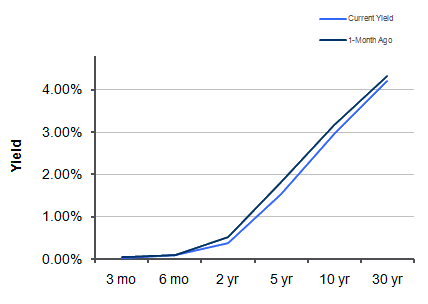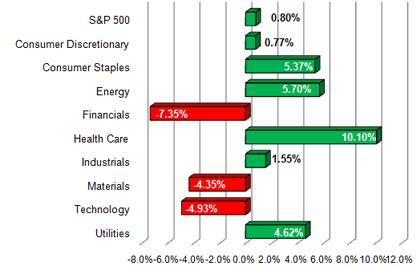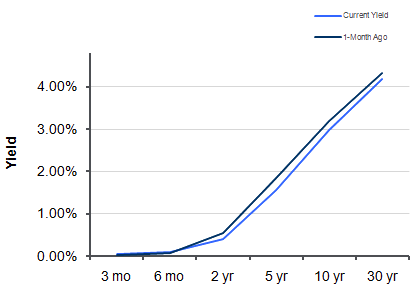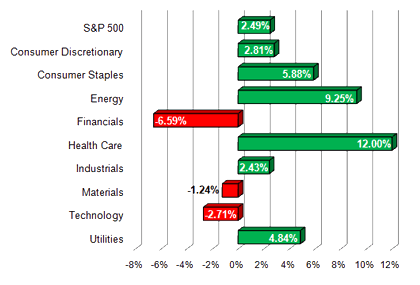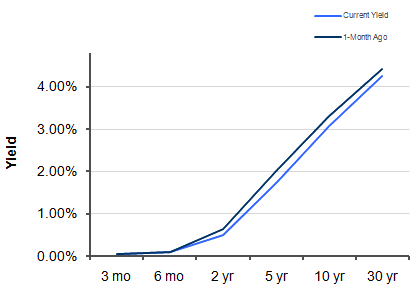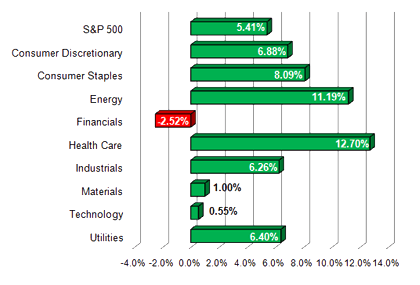
Market Commentary by Scott J. Brown, Ph.D., Chief Economist

The economic data were mixed – consistent with a near-term slowing in the pace of growth, but not a contraction. Retail sales fell 0.2% in May, reflecting a 2.9% drop in auto dealership sales (dampened by Japan’s disaster), but rose 0.3% ex-autos – not as bad as the market had feared. Industrial production edged up 0.1%, reflecting lingering supply-chain problems in autos and a drop in the output of utilities. Residential construction activity improved in May, but the underlying trend appears to be relatively flat. The Consumer Price Index exceeded expectations, rising 0.2% in May, up 0.3% ex-food & energy, boosted by higher prices of apparel and motor vehicles (which are likely to be temporary).
Worries about Greece contributed to a flight to safety in Treasuries. The 10-year Treasury note yield fell below 3%. Stock market volatility remained high as investors tried to assess the economic situation.
Next week, we’ll get May figures on home sales and durable goods orders, but the focus will be on the Fed’s policy statement and Chairman Bernanke’s second post-FOMC press briefing. The Federal Open Market Committee is expected to leave short-term interest rates unchanged and to retain the conditional commitment to keep rates low for “an extended period.” The wording of the economic assessment is likely to change a little. In his press briefing, Bernanke will first present revised projections of growth, unemployment, and inflation. He’s likely to suggest little chance of another round of asset purchases (the current $600 billion program will end this month, although the Fed will continue to reinvest maturing securities in its portfolio into long-term Treasuries to the tune of about $35 billion per month). Expect Bernanke to outline why the Fed expects the recent slowing in economic growth to be temporary. However, at the same time, he should not increased downside risks for the near term.
Indices
| Last | Last Week | YTD return % | |
| DJIA | 11961.52 | 12124.36 | 3.32% |
| NASDAQ | 2623.70 | 2684.87 | -1.10% |
| S&P 500 | 1267.64 | 1289.00 | 0.80% |
| MSCI EAFE | 1631.59 | 1689.50 | -1.61% |
| Russell 2000 | 781.54 | 792.64 | -0.27% |
Consumer Money Rates
| Last | 1-year ago | |
| Prime Rate | 3.25 | 3.25 |
| Fed Funds | 0.11 | 0.13 |
| 30-year mortgage | 4.49 | 4.83 |
Currencies
| Last | 1-year ago | |
| Dollars per British Pound | 1.613 | 1.483 |
| Dollars per Euro | 1.416 | 1.231 |
| Japanese Yen per Dollar | 80.720 | 91.390 |
| Canadian Dollars per Dollar | 0.984 | 1.025 |
| Mexican Peso per Dollar | 11.958 | 12.603 |
Commodities
| Last | 1-year ago | |
| Crude Oil | 94.95 | 77.67 |
| Gold | 1527.73 | 1230.53 |
Bond Rates
| Last | 1-month ago | |
| 2-year treasury | 0.37 | 0.53 |
| 10-year treasury | 2.94 | 3.18 |
| 10-year municipal (TEY) | 4.07 | 3.99 |
Treasury Yield Curve – 6/17/2011
S&P Sector Performance (YTD) – 6/17/2011
Economic Calendar
| June 21st | — | Existing Home Sales (May) FOMC Meeting Begins |
| June 22nd | — | FOMC Policy Decision Bernanke Press Conference |
| June 23rd | — | New Home Sales (May) |
| June 24th | — | Real GDP (1Q11, 3rd estimate) Durable Goods Orders (May) |
| July 4th | — | Independence Day (markets closed) |
| July 8th | — | Employment Report (June) |
| July 29th | — | Real GDP (2Q11 advance estimate) |
Treasury Yield Curve – 6/10/2011
S&P Sector Performance (YTD) – 6/10/2011
Economic Calendar
| June 14th | — | Producer Price Index (May) Retail Sales (May) |
| June 15th | — | Consumer Price Index (May) Empire State Manufacturing Index (June) Industrial Production (May) Homebuilder Sentiment (June) |
| June 16th | — | Jobless Claims (week ending June 11th) Current Account (1Q11) Building Permits, Housing Starts (May) Philadelphia Fed Survey (June) |
| June 17th | — | FConsumer Sentiment (mid-June) Leading Economic Indicators (May) |
| June 21st | — | Existing Home Sales (May) FOMC Meeting Begins |
| June 22nd | — | FOMC Policy Decision Bernanke Press Conference |
| June 23rd | — | New Home Sales (May) |
| June 24th | — | Real GDP (1Q11, 3rd estimate) Durable Goods Orders (May) |
| July 4th | — | Independence Day (markets closed) |
| July 8th | — | Employment Report (June) |
Treasury Yield Curve – 5/27/2011
S&P Sector Performance (YTD) – 5/27/2011
Economic Calendar
| May 30th | — | Memorial Day Holiday (markets closed) |
| May 31st | — | S&P/Case-Shiller Home Price Index (April) Chicago PM Index (May) Consumer Confidence (May) |
| June 1st | — | Challenger Layoffs (May) ADP Payroll Estimate (May) Construction Spending (April) ISM Manufacturing Index (May) Motor Vehicle Sales (May) |
| June 2nd | — | Jobless Claims (week ending May 28th) Productivity (1Q11, revised) |
| June 3rd | — | Employment Report (May) ISM Non-Manufacturing Index (May) |
| June 8th | — | Fed Beige Book |
| June 9th | — | Trade Balance (April) |
| June 14th | — | Retail Sales (May) |
| June 15th | — | Consumer Price Index (May) |
| June 21st-22nd | — | FOMC Meeting Bernanke Press Conference |
Important Disclosures
Past performance is not a guarantee of future results. There are special risks involved with global investing related to market and currency fluctuations, economic and political instability, and different financial accounting standards. The above material has been obtained from sources considered reliable, but we do not guarantee that it is accurate or complete. There is no assurance that any trends mentioned will continue in the future. While interest on municipal bonds is generally exempt from federal income tax, it may be subject to the federal alternative minimum tax, state or local taxes. In addition, certain municipal bonds (such as Build America Bonds) are issued without a federal tax exemption, which subjects the related interest income to federal income tax. Investing involves risk and investors may incur a profit or a loss.
US government bonds and treasury bills are guaranteed by the US government and, if held to maturity, offer a fixed rate of return and guaranteed principal value. US government bonds are issued and guaranteed as to the timely payment of principal and interest by the federal government. Treasury bills are certificates reflecting short-term (less than one year) obligations of the US government.
Commodities trading is generally considered speculative because of the significant potential for investment loss. Markets for commodities are likely to be volatile and there may be sharp price fluctuations even during periods when prices overall are rising. Specific sector investing can be subject to different and greater risks than more diversified investments.
Tax Equiv Muni yields (TEY) assume a 35% tax rate on triple-A rated, tax-exempt insured revenue bonds.
![]() Material prepared by Raymond James for use by its financial advisors.
Material prepared by Raymond James for use by its financial advisors.
The information contained herein has been obtained from sources considered reliable, but we do not guarantee that the foregoing material is accurate or complete. Data source: Bloomberg, as of close of business June 16th, 2011.
©2011 Raymond James Financial Services, Inc. member FINRA / SIPC.

